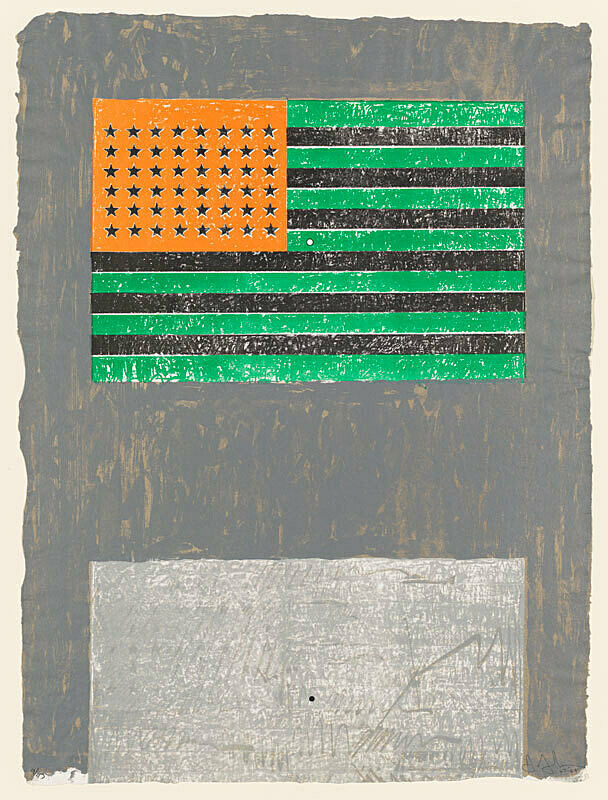Roy Lichtenstein
1923–1997
Alongside Andy Warhol and James Rosenquist, Roy Lichtenstein was a key figure of Pop art, a movement that emerged in the early 1960s and was distinguished by subject matter derived from pop culture and the use, or imitation, of mechanical reproduction techniques such as screenprinting. Lichtenstein studied art briefly with the Social Realist painter Reginald Marsh at the Art Students League in New York and then at Ohio State University, from which he received undergraduate and MFA degrees. In 1961 he arrived at his signature aesthetic: works whose subjects were loosely derived from comic strips, cartoons, or advertisements, painted in a style that mimicked commercial printing.
In Girl in Window, a study for a mural commissioned by the architect Philip Johnson for the New York State Pavilion at the 1964 World’s Fair, Lichtenstein represented the half figure of a comely female through a combination of simplified passages of solid color, bold black outlines, and areas of gridded dots. Yet his technique is more labor intensive, and manual, than his coolly detached surfaces—and their allusion to industrial reproduction—suggest. His process involved first sketching his selected subject, then projecting the drawing using an opaque projector, tracing the image onto canvas and, finally, filling in the outline with contours and dots, which were applied with a stencil to emulate the Benday dots of halftone printing processes.
In the mid-1960s Lichtenstein began to take the artist’s mark itself as a motif: Little Big Painting pictures the slashing brushwork and drippy runoff that characterized many an Abstract Expressionist canvas. Lichtenstein parodies this means of improvisatory mark making, and its associations with spontaneity and freedom, by rendering the strokes as if stylized and premeditated—substituting the look of anonymous commercial production for the uniqueness of the artist’s gesture.
Dana Miller and Adam D. Weinberg, Handbook of the Collection (New York: Whitney Museum of American Art, 2015), 230.
Introduction
Roy Fox Lichtenstein ( LIK-tən-STYN; October 27, 1923 – September 29, 1997) was an American pop artist. He rose to prominence in the 1960s through pieces which were inspired by popular advertising and the comic book style. Much of his work explores the relationship between fine art, advertising, and consumerism.
Whaam!, Drowning Girl, and Look Mickey proved to be Lichtenstein's most influential works. His most expensive piece is Masterpiece, which was sold for $165 million in 2017.
Lichtenstein's paintings were exhibited at the Leo Castelli Gallery in New York City, which represented him from 1961 onwards. His artwork was considered to be "disruptive". Lichtenstein described pop art as "not 'American' painting but actually industrial painting".
Wikidata identifier
Q151679
Information from Wikipedia, made available under the Creative Commons Attribution-ShareAlike License . Accessed December 4, 2025.
Introduction
Roy Lichtenstein attended classes at the Parsons School of Design and Art Students League before enrolling in the Fine Arts program at Ohio State in 1940. He was drafted into the United States Army, but was discharged and returned to Ohio in 1946 to finish his master's degree. In 1957 he accepted a teaching position at the State University of New York in Oswego, all the while pursuing his art career and gradually shifting his focus towards Expressionism. He began teaching at Rutgers University in 1960, and by 1961, he had created his first paintings of cartoon and comic strip icons with his trademark use of Benday dots. By 1964, Lichtenstein was one of Pop art's most recognized, yet controversial, artists.
Country of birth
United States
Roles
Artist, cinematographer, decorative artist, decorative painter, designer, graphic artist, jewelry designer, painter, sculptor
ULAN identifier
500013596
Names
Roy Lichtenstein, Roy Fox Lichtenstein
Information from the Getty Research Institute's Union List of Artist Names ® (ULAN), made available under the ODC Attribution License. Accessed November 23, 2025.


























